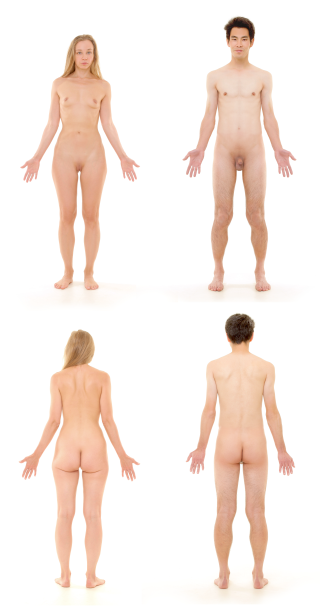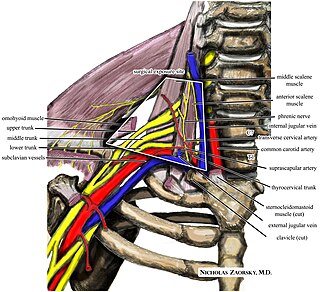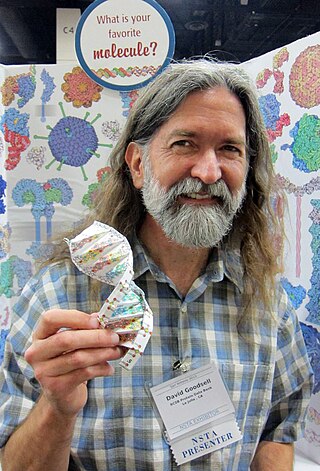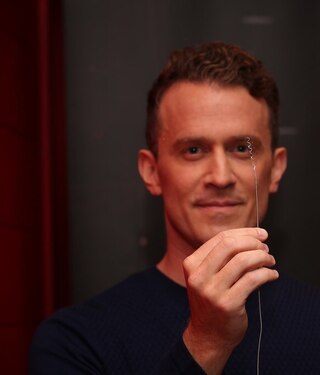
The human body is the entire structure of a human being. It is composed of many different types of cells that together create tissues and subsequently organs and then organ systems.

George Emil Palade was a Romanian-American cell biologist. Described as "the most influential cell biologist ever", in 1974 he was awarded the Nobel Prize in Physiology and Medicine along with Albert Claude and Christian de Duve. The prize was granted for his innovations in electron microscopy and cell fractionation which together laid the foundations of modern molecular cell biology, the most notable discovery being the ribosomes of the endoplasmic reticulum – which he first described in 1955.

An illustrator is an artist who specializes in enhancing writing or elucidating concepts by providing a visual representation that corresponds to the content of the associated text or idea. The illustration may be intended to clarify complicated concepts or objects that are difficult to describe textually, which is the reason illustrations are often found in children's books.
A brain–computer interface (BCI), sometimes called a brain–machine interface (BMI), is a direct communication link between the brain's electrical activity and an external device, most commonly a computer or robotic limb. BCIs are often directed at researching, mapping, assisting, augmenting, or repairing human cognitive or sensory-motor functions. They are often conceptualized as a human–machine interface that skips the intermediary of moving body parts (hands...), although they also raise the possibility of erasing the distinction between brain and machine. BCI implementations range from non-invasive and partially invasive to invasive, based on how physically close electrodes are to brain tissue.

The Yale School of Medicine is the medical school at Yale University, a private research university in New Haven, Connecticut. It was founded in 1810 as the Medical Institution of Yale College and formally opened in 1813.

Miguel Ângelo Laporta Nicolelis, is a Brazilian scientist, physician and Duke School of Medicine Professor in Neuroscience at Duke University, best known for his pioneering work surrounding brain-computer interface technology.
Bernhard Preim is a specialist in human–computer interface design as well as in visual computing for medicine. He is currently professor of visualization at University of Magdeburg, Germany.
Engineering Animation, Inc., or EAI, was a services and software company based in Ames, Iowa, United States. It remained headquartered there from its incorporation in 1990 until it was acquired in 2000 by Unigraphics Solutions, Inc., now a subsidiary of the German technology multinational Siemens AG. During its existence, EAI produced animations to support litigants in court, wrote and sold animation and visualization software, and developed a number of multimedia medical and computer game titles. Part of EAI's business now exists in a spin-off company, Demonstratives.

Medical illustrations can be illustrations or animations that are created to visually represent medical or biological subjects that can be difficult to explain only using words

The Inner Life of the Cell is an 8.5-minute 3D computer graphics animation illustrating the molecular mechanisms that occur when a white blood cell in the blood vessels of the human body is activated by inflammation. It shows how a white blood cell rolls along the inner surface of the capillary, flattens out, and squeezes through the cells of the capillary wall to the site of inflammation where it contributes to the immune reaction.
Bin He is a Chinese American biomedical engineering scientist. He is the Trustee Professor of the Department of Biomedical Engineering, professor by courtesy in the Department of Electrical and Computer Engineering, and Professor of Neuroscience Institute, and was the head of the department of Biomedical Engineering at Carnegie Mellon University. Prior, he was Distinguished McKnight University Professor of Biomedical Engineering and Medtronic-Bakken Endowed Chair for Engineering in Medicine at the University of Minnesota. He previously served as the director of the Institute for Engineering in Medicine and the Center for Neuroengineering at the University of Minnesota. He was the Editor in Chief of the IEEE Transactions on Biomedical Engineering and serves as the editor in chief of IEEE Reviews in Biomedical Engineering. He was the president of the IEEE Engineering in Medicine & Biology Society (EMBS) from 2009 to 2010 and chair of International Academy of Medical and Biological Engineering from 2018 to 2021.

The University of Utah School of Medicine is located on the upper campus of the University of Utah in Salt Lake City, Utah. It was founded in 1905 and is currently the only MD-granting medical school in the state of Utah.

Computer-generated imagery (CGI) is a specific-technology or application of computer graphics for creating or improving images in art, printed media, simulators, videos and video games. These images are either static or dynamic. CGI both refers to 2D computer graphics and 3D computer graphics with the purpose of designing characters, virtual worlds, or scenes and special effects. The application of CGI for creating/improving animations is called computer animation, or CGI animation.

David S. Goodsell, is an associate professor at the Scripps Research Institute and research professor at Rutgers University, New Jersey. He is especially known for his watercolor paintings of cell interiors.
A medical animation is a short educational film, usually based around a physiological or surgical topic, that is rendered using 3D computer graphics. While it may be intended for an array of audiences, the medical animation is most commonly utilized as an instructional tool for medical professionals or their patients.
XVIVO Scientific Animation is an American scientific and medical animation studio based in Hartford, Connecticut, United States. It was founded in 2001 by David Bolinsky, former lead medical illustrator at Yale University, and Michael Astrachan. The company is most known for its short film The Inner Life of the Cell, which debuted at the 2006 SIGGRAPH conference in Boston. The project was commissioned by Harvard University’s Department of Molecular and Cellular Biology, which currently holds the rights to the piece.

The Kahlert School of Computing is a school within the College of Engineering at the University of Utah in Salt Lake City, Utah.
Janet Iwasa is an American data visualization expert and assistant professor of biochemistry at the University of Utah.
Ali R. Rezai is an Iranian-born American neurosurgeon and neuroscientist. His work and research has focused on neuromodulation treatments for patients with neurological and mental health conditions, including neuromodulation techniques such as deep brain stimulation (DBS) through brain chip implants to treat Parkinson's disease tremors, obsessive–compulsive disorder, Alzheimer's disease, traumatic brain injury, spinal cord injury, and addiction. Recent research since 2020 has focused on deep brain stimulation for addiction treatment, as well as focused ultrasound to treat tremor, addiction and Alzheimer's disease.

Thomas J. Oxley is the chief executive officer of Synchron and neurointerventionist at Mount Sinai Hospital in New York City. Trained as a vascular and interventional neurologist, he established the Vascular Bionics laboratory at the University of Melbourne and is currently co-head of this lab. Oxley is best known for founding Synchron, a company building next-generation brain computer interface solutions that has recently announced the first clinical data on a novel stent electrode (Stentrode) neural interface that is inserted through blood vessels. The company was initiated sometime after his cold-call to DARPA for funding, and has received substantial funding from the U.S. Defense Advanced Research Projects Agency (DARPA) and the Australian government to research this minimally-invasive neural interface technology.












